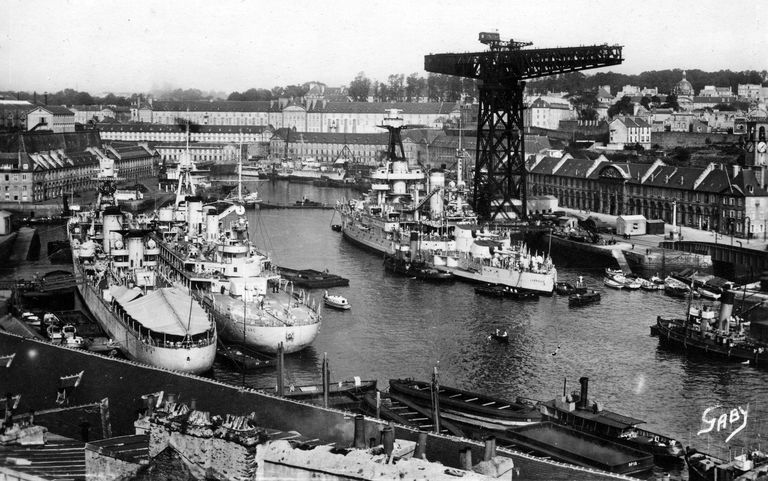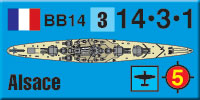The Cruel Sea:
French Battleships, Part Five
by Mike Bennighof, Ph.D.
October 2022
 Our alternative-history expansion set Second Great War at Sea: The Cruel Sea creates a war that never happened, at least not in the way we portray it. It’s a battleship war, with aircraft in an ancillary role, where big guns determine the outcome of the war at sea. France and Russia square off in the North Atlantic and Arctic Ocean against the powerful Imperial German High Seas Fleet. Our alternative-history expansion set Second Great War at Sea: The Cruel Sea creates a war that never happened, at least not in the way we portray it. It’s a battleship war, with aircraft in an ancillary role, where big guns determine the outcome of the war at sea. France and Russia square off in the North Atlantic and Arctic Ocean against the powerful Imperial German High Seas Fleet.
The French battle fleet is built around 25 battleships – 10 of them modern fast battleships, none of which were actually completed but all of which were designed and authorized for construction. We went over the Richelieu class and Gascogne class in earlier installments. Both types carried eight 15-inch guns apiece and were designed to meet the Washington naval agreement limit of 35,000 tons’ displacement.
The 1936 London Treaty retained the 35,000-ton barrier and proposed a new maximum gun caliber of 14 inches, as opposed to the former 16-inch limit. The United States insisted on language voiding those limits if Japan did not sign the treaty, and in March 1937 invoked the so-called “escalator clause” as the Japanese had not inked the agreement. In June 1938, well before the battleship Gascogne had been laid down, France joined the United States and Britain in setting a new size limit for battleships at 45,000 tons, retaining the 16-inch gun as the largest allowed.
The French immediately declared that they would not build ships of that size unless some other European power did so. French marine infrastructure already strained to handle the Richelieu class, then under construction. A new program of dockyard expansion began in 1940, with the Laninon Docks at the Brest Naval Arsenal receiving a large building dock and a large graving dock for repairs, plus new slipways on which cruisers could be built, a massive array of machine shops and new cranes.

Spoils of war: The giant floating crane hovers over
the battleship Lorraine.
Cranes proved a serious problem – only the Brest Arsenal had a floating crane capable of lifting the barrels of 15-inch guns, a machine taken from Germany as reparations after the First World War. No French firm could supply a crane of similar dimensions and power, reducing the Navy to attempt to buy a commercially-owned crane from the Port of Le Havre. Only six docks in France could accommodate a 35,000-ton battleship, and only one existing dock (plus the new one to be constructed at Brest) could handle a 40,000-ton ship. None could repair a 45,000-ton battleship, though several could be enlarged.
Even tugboats powerful enough to move such a ship proved in short supply, and French shipyards had no excess capacity available to build them. The Marine Nationale attempted to buy new tugboats from Dutch shipbuilders, but the Netherlands’ government vetoed the deal as a violation of neutrality laws, and the French even sounded out Italian shipbuilders.
Nevertheless, when the French learned that the Germans had laid down two battleships of the gigantic H class, the Marine Nationale had to respond. In July 1939 Vice Admiral François Darlan, Chief of the Naval Staff, asked the Service Technique des Constructions Navales for proposals for new battleships of 40,000, 42,500 and 45,000 tons, armed with 15-inch or 16-inch guns. At the same time, he asked the Navy’s ordnance department for new proposals for 15.75-inch, 16-inch and 16.5-inch heavy guns.

Building the battleship: Jean Bart under construction at
Chantiers de Penhöet.
In late 1939 the architects presented him with three options. All three ships had a similar hull form to Richelieu, but with improved armor schemes and underwater protection. Proposal 1 featured three turrets, each with three 15-inch guns, and weighed in at 40,000 tons. Proposal 2 was simply an enlarged Proposal 1, displacing 42,500 tons and carrying nine 16-inch guns instead. Proposal 3 reverted to the quadruple turret of the previous classes, with two of them forward like Richelieu and one aft like Gascogne, for a total of a dozen 15-inch guns on a displacement of 45,000 tons.
Darlan and the admirals liked the third proposal the best, but ultimately chose the first as more suited to existing French infrastructure – she could just barely be built in the same graving docks as the previously classes, and docked in the same repair docks. Two of them were authorized in April 1940; one to be built on the slipway at Chantiers de Penhöet’s private yard in Saint-Nazaire, currently occupied by the aircraft carrier Joffre, while the second would be built in the new graving dock being excavated at the Brest Naval Arsenal. The two ships – one to be named Alsace and the other either Normandie, Flandre or Bourgogne – were never begun, and no work resumed after the war.
For The Cruel Sea we chose Proposal 3 for Alsace, the much larger ship with a much more powerful armament. In our alternative history, the Great Depression has been far less great, leaving France with much greater resources and with far less damage to her shipbuilding industry. A long-term naval buildup (and attendant arms race) has given the Republic the infrastructure to support the project Darlan would have preferred without compromising the ship’s capabilities.
Alsace is much larger than Richelieu, 45,000 tons and 265 meters long compared to 37,250 tons and 242 meters long. She would carry the same quadruple turret as the previous classes; the rapid pace of the French naval building program meant that the problems with the turret and the Model 1935 15-inch gun that would plague Richelieu were not yet evident.

Bow turrets of Alsace, showing the paired 15-inch guns.
The new ship would have three or four triple turrets for the supposedly dual-purpose 6-inch Model 1930 guns. In one sketch three would be mounted along the centerline with one firing over the two forward main turrets and the other two firing over the aft main turret (similar to Gascogne, which had two secondary turrets forward and one aft). Another version had one super-firing fore and aft, with two more mounted aft on either side of the elevated turret (this is the version seen in The Cruel Sea). Medium anti-aircraft cover would be provided by two dozen 3.9-inch Model 1933 guns in twelve dual mounts, supplemented by a large array of light anti-aircraft weaponry.
A huge power plant would provide 220,000 horsepower for an expected top speed of 32 knots. She would have two catapults on the fantail with a seaplane hangar sunk into the deck. Outwardly the ship would resemble Richelieu, with the same superstructure. Inwardly she would have a similar protection scheme, with thicker armor over her machinery and magazines.
Alsace would have been a powerful fighting ship, on paper the equivalent of an American Iowa-class ship. In reality, she would not have been so thanks to the problems with her main armament (a tendency to hang fire, a slow rate of fire and a lack of high-explosive ammunition) and her secondary guns (an inability to actually track flying targets).
 In The Cruel Sea, Alsace gets her full capabilities (either the French have produced better guns, or licensed them from Ansaldo) and a full class with three sisters, here named Bourgogne, Poitou and Champagne. They’re a match for the best the Germans can throw at them, making for some intense battleship action on the high seas. In The Cruel Sea, Alsace gets her full capabilities (either the French have produced better guns, or licensed them from Ansaldo) and a full class with three sisters, here named Bourgogne, Poitou and Champagne. They’re a match for the best the Germans can throw at them, making for some intense battleship action on the high seas.
You can order The Cruel Sea right here, right now.
Sign up for our newsletter right here. Your info will never be sold or transferred; we'll just use it to update you on new games and new offers.
Mike Bennighof is president of Avalanche Press and holds a doctorate in history from Emory University. A Fulbright Scholar and NASA Journalist in Space finalist, he has published a great many books, games and articles on historical subjects; people are saying that some of them are actually good.
He lives in Birmingham, Alabama with his wife and three children. He will never forget his Iron Dog, Leopold.
Want to keep Daily Content free of third-party ads? You can send us some love (and cash) through this link right here.
|
